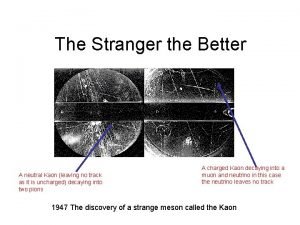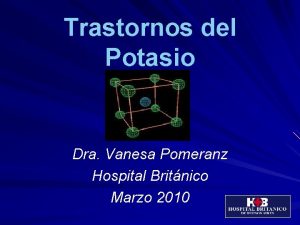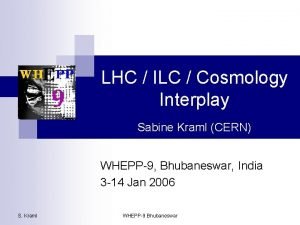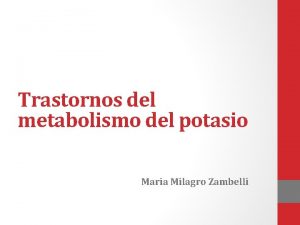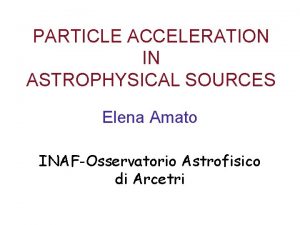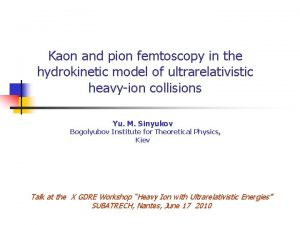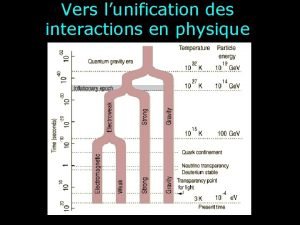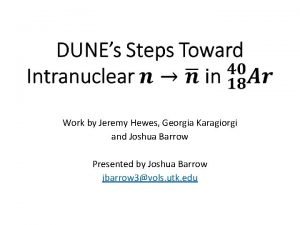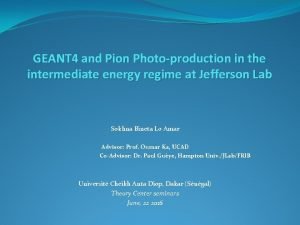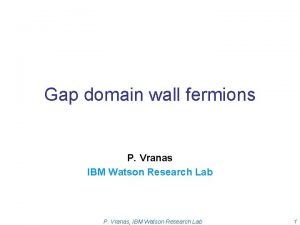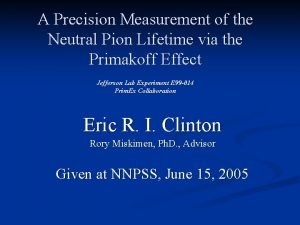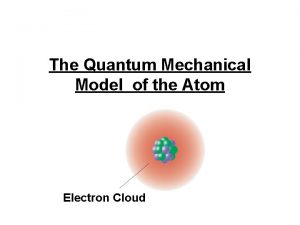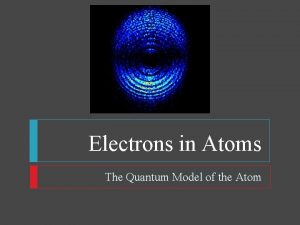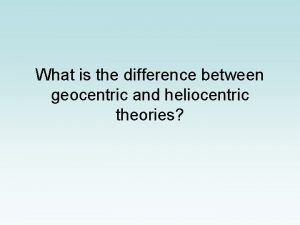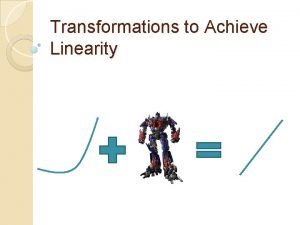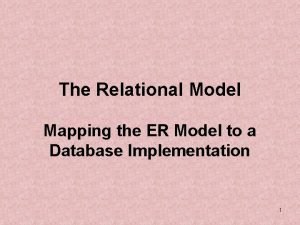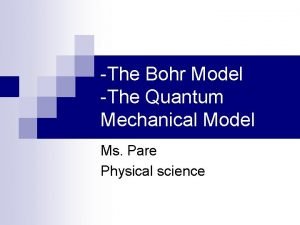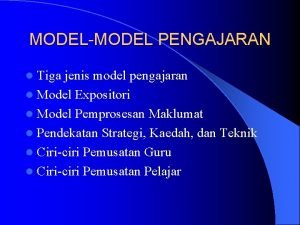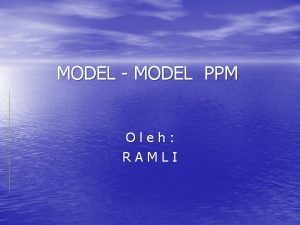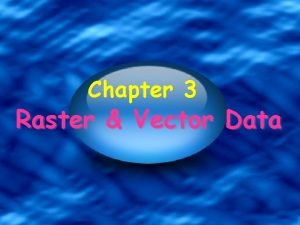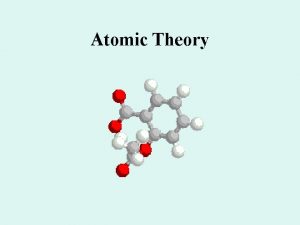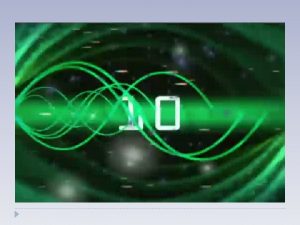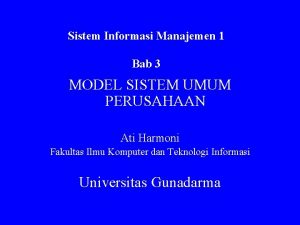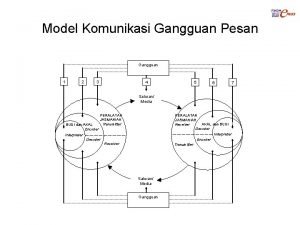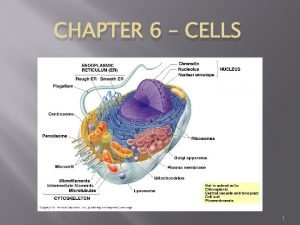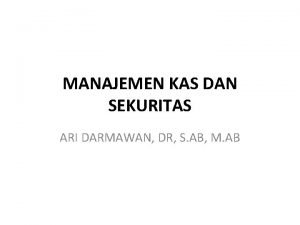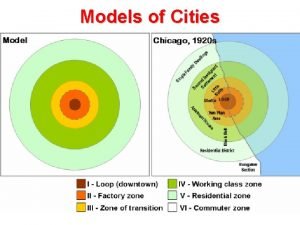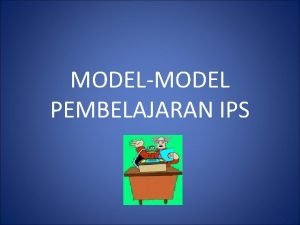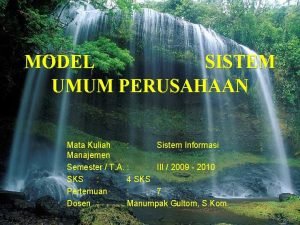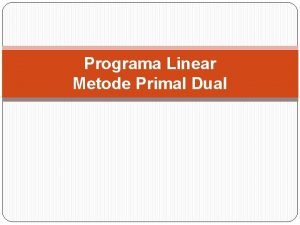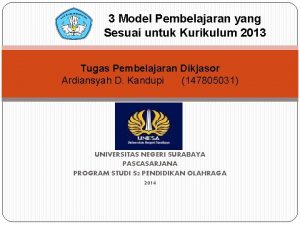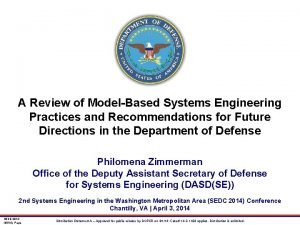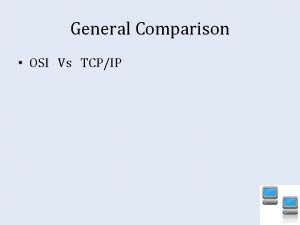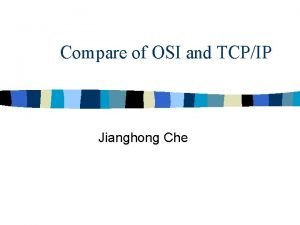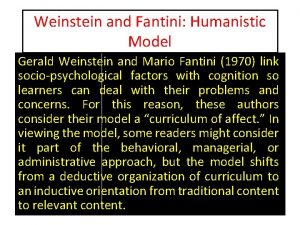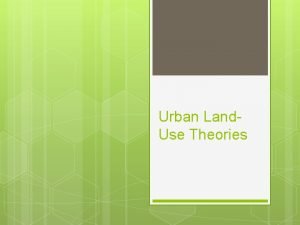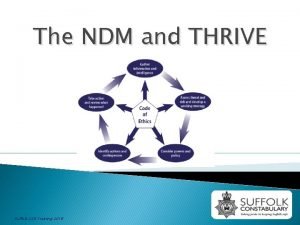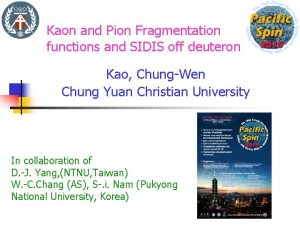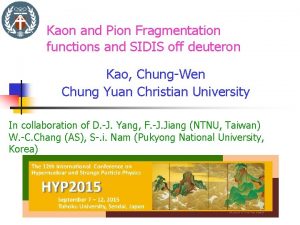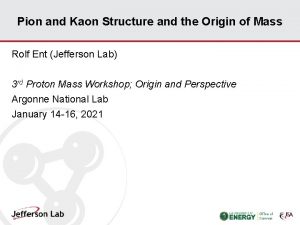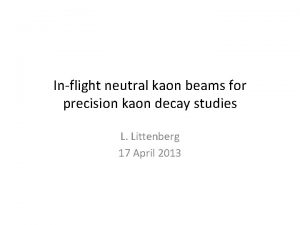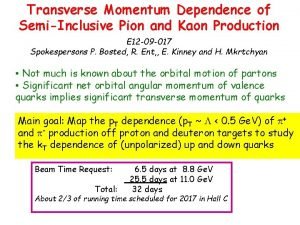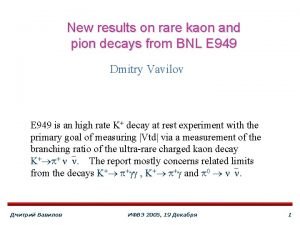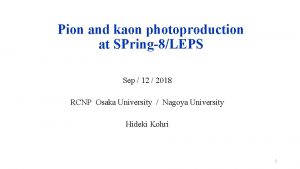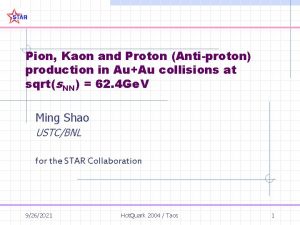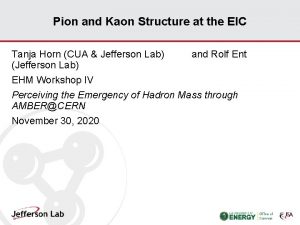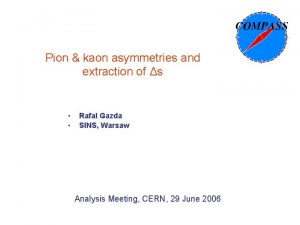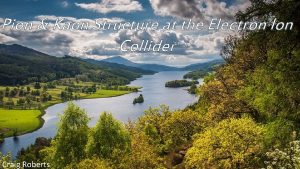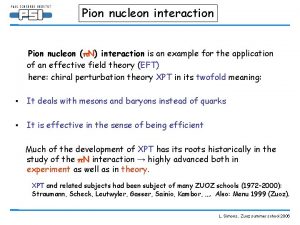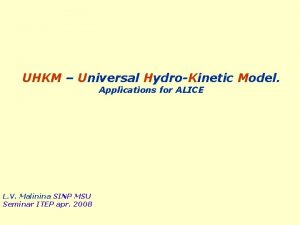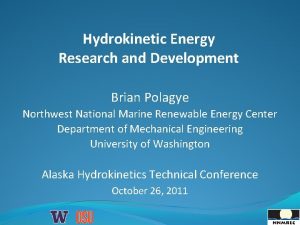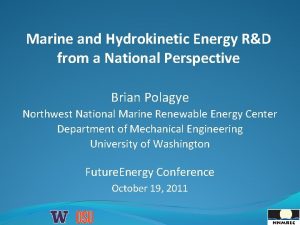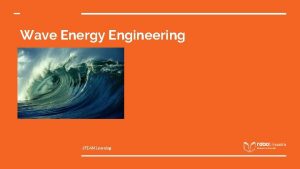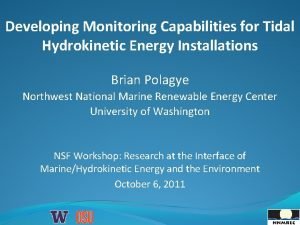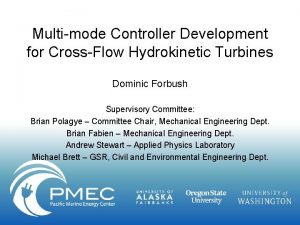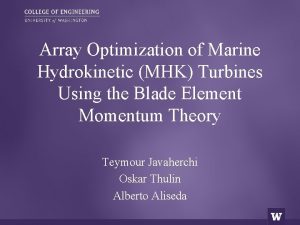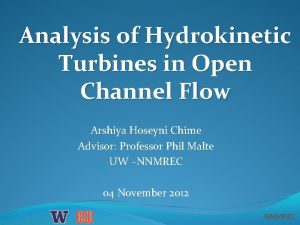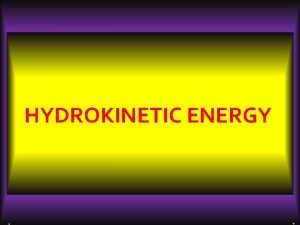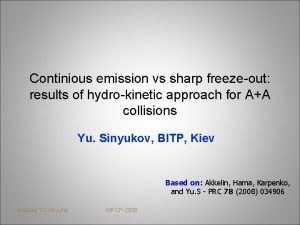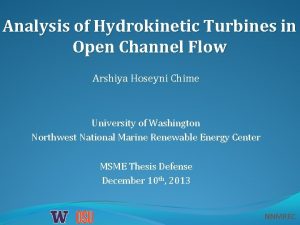Kaon and pion femtoscopy in the hydrokinetic model

























































































































- Slides: 121

Kaon and pion femtoscopy in the hydrokinetic model of ultrarelativistic heavy-ion collisions Yu. M. Sinyukov Bogolyubov Institute for Theoretical Physics, Kiev Talk at the X GDRE Workshop “Heavy Ion with Ultrarelativistic Energies” SUBATRECH, Nantes, June 17 2010

OUTLOOK • • 0. Evidences of collective/hydrodynamic behavior of the matter formed A+A. I. Thermalization (is early thermalization really needed? ), IC, HBT-puzzle and all that… • II. The transition from very initial nonthermal state in HIC to hydrodynamic stage. Phenomenological approach. • III. Matter evolution at chemically equilibrated stage. • IV. Matter evolution at non-equilibrated stage. Hydro. Kinetic Model (HKM). • V. System’s decay and spectra formation. Whether it possible to apply Cooper-Frye prescription for continuously emitting and not equilibrated system? If possible, how? • VI. The HKM results for the top RHIC energies. Pion and kaon femtoscopy • VII. Energy dependence of the interferometry scales: SPS, RHIC, LHC

The evidences of space-time evolution of thermal matter in A+A collisions: § Rough estimate of the fireball lifetime for Au+Au In p+p all femto-scales are of order 1 fm ! The phenomenon of space-time evolution of the strongly interacting matter in A+A collisions Particle number ratios are well reproduced in ideal gas model with 2 parameters: T, for collision energies from AGS to RHIC: thermal+chemical equilibrium Gev: A+A is not some kind of superposition of the individual collisions of nuclei What is the nature of this matter at the early collision stage? Whether does the matter becomes thermal?



Collective expansion of the fireball. §Observation of the longitudinal boost-inv. expansion: It was conformed by NA 35/NA 49 Collaborations (CERN), 1995 ! §Observation of transverse (radial) collective flows: Effective temperature for different particle species (non-relativistic case) : radial collective flow §Observation of elliptic flows: HYDRODYNAMICS !

Expecting Stages of Evolution in Ultrarelativistic A+A collisions t Relatively small space-time scales (HBT puzzle) 8 -20 fm/c Early thermal freeze-out: T_th Tch 150 Me. V 7 -8 fm/c Elliptic flows 1 -3 fm/c Early thermalization at 0. 5 fm/c 0. 2? (LHC) or strings 7

8

Collective velocities developed between =0. 3 and =1. 0 fm/c Central collisions Collective velocity developed at pre-thermal stage from proper time tau_0 =0. 3 fm/c by supposed thermalization time tau_th = 1 fm/c for scenarios of partonic free streaming and free expansion of classical field. The results are compared with the hydrodynamic evolution of perfect fluid with hard equation of state p = 1/3 epsilon started at. Impact parameter b=0. Yu. S. Acta Phys. Polon. B 37 (2006) 3343; Gyulassy, Yu. S. , Karpenko, Nazarenko Braz. J. Phys. 37 (2007) 1031. Yu. S. , Nazarenko, Karpenko: Acta Phys. Polon. B 40 1109 (2009).

Collective velocities and their anisotropy developed between and =1. 0 fm/c =0. 3 Non-central collisions b=6. 3 fm Collective velocity developed at pre-thermal stage from proper time =0. 3 fm/c by supposed thermalization time tau_i = 1 fm/c for scenarios of partonic free streaming. The results are compared with the hydrodynamic evolution of perfect fluid with hard equation of state p = 1/3 epsilon started at. Impact parameter b=6. 3 fm.

Basic ideas for the early stage: developing of pre-thermal flows Yu. S. Acta Phys. Polon. B 37 (2006) 3343; Gyulassy, Yu. S. , Karpenko, Nazarenko Braz. J. Phys. 37 (2007) 1031. For nonrelativistic gas For thermal and non-thermal expansion at Hydrodynamic expansion: gradient pressure acts : So, even if : and Free streaming: Gradient of density leads to non-zero collective velocities In the case of thermalization at later stage it leads to spectra anisotropy 11

Summary-1 Yu. S. , Nazarenko, Karpenko: Acta Phys. Polon. B 40 1109 (2009) Ø The initial transverse flow in thermal matter as well as its anisotropy are developed at pre-thermal - either partonic, string or classical field (glasma) - stage with even more efficiency than in the case of very early perfect hydrodynamics. Ø Such radial and elliptic flows develop no matter whether a pressure already established. The general reason for them is an essential finiteness of the system in transverse direction. Ø The anisotropy of the flows transforms into asymmetry of the transverse momentum spectra only of (partial) thermalization happens. Ø So, the results, first published in 2006, show that whereas the assumption of (partial) thermalization in relativistic A + A collisions is really crucial to explain soft physics observables, the hypotheses of early thermalization at times less than 1 fm/c is not necessary. 12

Phenomenological model of pre-thermal evolution Akkelin, Yu. S. PRC 81, 064901 (2010) Matching of nonthermal initial conditions and hydrodynamic stage • If some model (effective QCD theory) gives us the energy-momentum tensor at time , one can estimate the flows and energy densities at expected time of thermalization , using hydrodynamic equation with (known) source terms. • This phenomenological approach is motivated by Boltzmann equations, accounts for the energy and momentum conservation laws and contains two parameters: supposed time of thermalization and “initial” relaxation time. Eqs: IC: where 13

Hydro. Kinetic Model (HKM) of A+A collisions I. Matter evolution in chemically equilibrated space-time zone 14

Locally (thermally & chemically) equilibrated evolution and initial conditions (IC) t Tch IC for central Au+Au collisions The “effective" initial distribution is the one which being used in the capacity of initial condition bring the average hydrodynamic results for fluctuating initial conditions: x is Glauber-like profile I. Initial rapidity profiles: where II. is CGC-like profile and are only fitting parameters in HKM

Equation of state in (almost) equilibrated zone Me. V Eo. S from Latt. QCD (in form proposed by Laine & Schroder, Phys. Rev. D 73, 2006). Crossover transition, Latt. QCD is matched with an ideal chemically equilibrated multicomponent hadron resonance gas at Particle number ratios F. Karsch, Po. S CPOD 07: 026, 2007 are baryon number and strangeness susceptibilities 16

HKM II. Evolution of the hadronic matter in non-equlibrated zone. t Decay of the system and spectra formation Tch x

A “Soft Physics” measurements x t Landau, 1953 Δ ω K Cooper-Frye prescription (1974) A p=(p 1+ p 2)/2 Long q= p 1 - p 2 Sid e p 1 p 2 Out QS correlation function Space-time structure of the matter evolution: p BW 18

Cooper-Frye prescription (CFp) t t z r CFp gets serious problems: Freeze-out hypersurface contains non-space-like sectors artificial discontinuities appears across Sinyukov (1989), Bugaev (1996), Andrelik et al (1999); cascade models show that particles escape from the system about whole time of its evolution. Hybrid models (hydro+cascade) and the hydro method of continuous emission starts to develop.

Hybrid models: HYDRO + Ur. QMD (Bass, Dumitru (2000)) t t t Ur. QMD HYDRO z r The problems: the system just after hadronization is not so dilute to apply hadronic cascade models; hadronization hypersurface contains non-space-like sectors (causality problem: Bugaev, PRL 90, 252301, 2003); The average energy density and pressure of input Ur. QMD gas should coincide with what the hadro gas has just before switching. At r-periphery of space-like hypsurf. the system is far from l. eq. The initial conditions for hadronic cascade models should be based on non -local equilibrium distributions

Possible problems of matching hydro with initially bumping IC RIDGES? The example of boost-invariant hydroevolution for the bumping IC with four narrow high energy density tubes (r= 1 fm) under smooth Gaussian background (R=5. 4 fm)



























































Possible problems of matching hydro with initially bumping IC RIDGES? The example of boost-invariant hydroevolution for the bumping IC with ten narrow high energy density tubes (r= 1 fm) under smooth Gaussian background (R=5. 4 fm)


Continuous Emission t x F. Grassi, Y. Hama, T. Kodama (1995) “The back reaction of the emission on the fluid dynamics is not reduced just to energy-momentum recoiling of emitted particles on the expanding thermal medium, but also leads to a rearrangement of the medium, producing a deviation of its state from the local equilibrium, accompanied by changing of the local temperature, densities, and collective velocity field. This complex effect is mainly a consequence of the fact that the evolution of the single finite system of hadrons cannot be split into the two components: expansion of the interacting locally equilibrated medium and a free stream of emitted particles, which the system consists of. Such a splitting, accounting only for the momentumenergy conservation law, contradicts the underlying dynamical equations such as a Boltzmann one. ” Akkelin, Hama, Karpenko, Yu. S PRC 78 034906 (2008)

Hydro-kinetic approach Yu. S. , Akkelin, Hama: PRL 89 , 052301 (2002); + Karpenko: PRC 78, 034906 (2008). MODEL • is based on relaxation time approximation for emission function of relativistic finite expanding system; • provides evaluation of escape probabilities and deviations (even strong) of distribution functions [DF] from local equilibrium; 3. accounts for conservation laws at the particle emission; • • • Complete algorithm includes: solution of equations of ideal hydro; calculation of non-equilibrium DF and emission function in first approximation; solution of equations for ideal hydro with non-zero left-hand-side that accounts for conservation laws for non-equilibrium process of the system which radiated free particles during expansion; Calculation of “exact” DF and emission function; Evaluation of spectra and correlations.

Boltzmann equations and probabilities of particle free propagation Boltzmann eqs (differential form) and are G(ain), L(oss) terms for p. species Probability of particle free propagation (for each component ) 84 84

Spectra and Emission function Boltzmann eqs (integral form) Index is omitted everywhere Spectrum Relax. time approximation for emission function (Yu. S. , Akkelin, Hama PRL, 2002) For (quasi-) stable particles 85

Kinetics and hydrodynamics below Tch =165 Me. V For hadronic resonances & where

Representations of non-loc. eq. distribution function (for quasi- stable particles) If at the initial (hadronisation) time 87

Iteration procedure: I. Solution of perfect hydro equations with given initial l. eq. conditions 88

II. Decomposition of energy-momentum tensor 89

III. Ideal hydro with “source” instead of non-ideal hydro where (known function) 90

Full procedure for HKM The first correction for the back reaction of particle emission on the fluid dynamics This approach accounts for conservation laws deviations from loc. eq. viscosity effects in hadron gas: 91

Equation of state in non-equilibrated zone Me. V Eo. S Pressure and energy density of multicomponent Boltzmann gas At hypersurface the hadrons are in chemical equilibrium with some barionic chemical potential which are defind from particle number ratio (conception of chemical freeze-out). Below we account for the evolution of all N densities of hadron species in hydro calculation with decay resonances into expanding fluid, and compute Eo. S dynamically for each chemical composition of N sorts of hadrons in every hydrodynamic cell in the system during the evolution. Using this method, we do not limit ourselves by chemically frozen or chemically equilibrated evolution, keeping nevertheless thermodynamically consistent scheme. 92

Eo. S used in HKM calculations for the top RHIC energy The gray region consists of the set of the points corresponding to the different hadron gas compositions at each occurring during the late nonequilibrium stage of the evolution.

System's decoupling and spectra formation n Emission function For pion emission is the total collision rate of the pion, carrying momentum p with all the hadrons h in the system in a vicinity of point x. is the space-time density of pion production caused by gradual decays during hydrodynamic evolution of all the suitable resonances H including cascade decays The cross-sections in the hadronic gas are calculated in accordance with Ur. QMD. 94

PARAMETERS for the RHIC TOP ENERGY Fitting parameter at Max initial energy density § Glauber IC CGC IC 16. 5 Ge. V/fm 3 19. 5 Ge. V/fm 3 Initial transverse flows 0. 22 0. 21 Parameter “absorbs” unknown portion of the prethermal flows, the viscosity effects in the QGP and, in addition, the event-by-event fluctuations of the initial conditions which also lead to an increase of the “effective” transverse flows in the observed inclusive spectra. In CGC approach at RHIC energies this energy density corresponds to the value In CGC approach at RHIC energies the value (T. Lappi, J. Phys. G, 2008) is used 95

Iu. Karpenko, Yu. S. PRC 81, 054903 (2010)

The following factors reduces space-time scales of the emission and Rout/Rside ratio: Akkelin, Hama, Karpenko, Yu. S, PRC 78, 034906 (2008) § essentially non-flat initial energy density distributions (Gaussian, Glauber, CGC); § more hard transition Eo. S, corresponding to cross-over (not first order phase transition!); § fairly strong transverse flow at the late stage of the system evolution. It is caused by: Ø developing of flows at very early pre-thermal stage; Ø additional developing of transv. flow due to shear viscosity (Teaney, 2003); Ø effective increase of transv. flow due to initially bumping structure (Grassy, Hama, Kodama – 2008) ; + § correct description of evolution and decay of strongly interacting and chemically/thermally non-equilibrated system after hadronisation! Karpenko, Yu. S. PRC 81, 054903 (2010) 97



Pion, kaon and proton emission densities (Gaussian IC, vacuum c. s. ) T=80 Me. V T=145 Me. V At the point of maximal pion emission 100

Conclusion § The HKM allows one to restore the initial conditions and space-time picture of the matter evolution in central Au + Au collisions at the top RHIC energy. § The analysis, which is based on a detailed reproduction of the pion and kaon momentum spectra and measured femtoscopic scales, demonstrates that basically the pictures of the matter evolution and particle emission are similar at both Glauber and CGC IC with, however, different initial maximal energy densities: it is about 20% more for the CGC IC. § The process of decoupling the fireballs created in Au + Au collision lasts from about 8 to 20 fm/c, more than half the fireball’s total lifetime. The temperatures in the regions of the maximal emission are different at the different transverse momenta of emitting pions: T ≈ 75– 110 Me. V for p. T = 0. 2 Ge. V/c and T ≈ 130– 135 Me. V for p. T = 1. 2 Ge. V/c. § A comparison of the pion and kaon emissions at the same transverse mass demonstrates the similarity of the positions of emission maxima, which could point out to the reason for an approximate m. T-scaling.

Iu. Karpenko, Yu. S. PLB 688, 50 (2010)

Pion spectra at top SPS, RHIC and two LHC energies in HKM

Long- radii at top SPS, RHIC and two LHC energies in HKM

Side- radii at top SPS, RHIC and two LHC energies in HKM

Out- radii at top SPS, RHIC and two LHC energies in HKM

Out- to side- ratio at top SPS, RHIC and two LHC energies in HKM

Emission functions for top SPS, RHIC and LHC energies

The ratio as function on in-flow and energy At some p 2 1

Conclusion § The main mechanisms that lead to the paradoxical behavior of the interferometry scales, are exposed. § In particular, decrease of ratio with growing energy and saturation of the ratio at large energies happens due to a magnification of positive correlations between space and time positions of emitted pions and a developing of pre-thermal collective transverse flows.

BACK UP SLIDES

Saddle point approximation Spectrum Emission density where Normalization condition Eqs for saddle point Physical conditions at Dnepropetrovsk May 3 2009 : 112 NPQCD-2009

Cooper-Frye prescription Spectrum in new variables Emission density in saddle point representation Temporal width of emission Generalized Cooper-Frye f-la 113 Dnepropetrovsk May 3 2009 NPQCD-2009

Generalized Cooper-Frye prescription: t 0 Escape probability r 114 Yu. S. (1987)-particle flow conservation; K. A. Bugaev (1996) (current form) Nov 3 -6 RANP 08

Momentum dependence of freeze-out Here and further for Pb+Pb collisions we use: Pt-integrated initial energy density Eo. S from Lattice QCD when T< 160 Me. V, and Eo. S of chemically frozen hadron gas with 359 particle species at T< 160 Me. V. Nov 3 -6 115 RANP 08

The pion emission function for different p. T in hydro-kinetic model (HKM) The isotherms of 80 Me. V is superimposed.

The pion emission function for different p. T in hydro-kinetic model (HKM). The isotherms of 135 Me. V (bottom) is superimposed.

Transverse momentum spectrum of pi− in HKM, compared with the sudden freeze-out ones at temperatures of 80 and 160 Me. V with arbitrary normalizations.

Conditions for the utilization of the generalized Cooper-Frye prescription i) For each momentum p, there is a region of r where the emission function has a sharp maximum with temporal width. ii) The width of the maximum, which is just the relaxation time ( inverse of collision rate), should be smaller than the corresponding temporal homogeneitylength of the distribution function: 1% accuracy!!! iii) The contribution to the spectra from the residual region of r where the saddle point method is violated does not affect essentially the particle momentum spectrum. iiii) The escape probabilities for particles to be liberated just from the initial hyper-surface t 0 are small almost in the whole spacial region (except peripheral points) Then the momentum spectra can be presented in Cooper-Frye form despite it is, in fact, not sadden freeze-out and the decaying region has a finite temporal width. Also, what is very important, such a generalized Cooper-Frye representation is related to freeze-out hypersurface that depends on momentum p and does not necessarily encloses the initiall dense matter. 119 Dnepropetrovsk May 3 2009 NPQCD-2009

A “Soft Physics” measurements x t Landau, 1953 Δ ω K Cooper-Frye prescription (1974) A p=(p 1+ p 2)/2 Long q= p 1 - p 2 Sid e p 1 p 2 Out QS correlation function Space-time structure of the matter evolution: p BW 120

Conclusions The CFp might be applied only in a generalized form, accounting for the direct momentum dependence of the freeze-out hypersurface corresponding to the maximum of the emission function at fixed momentum p in an appropriate region of r. 121
 Kaon
Kaon Manejo hipopotasemia
Manejo hipopotasemia Kaon cp violation
Kaon cp violation Solucion polarizante hiperkalemia
Solucion polarizante hiperkalemia Inverse compton
Inverse compton Pion
Pion Louis pion montre
Louis pion montre Pion
Pion Pion geant
Pion geant Gdwf
Gdwf Pion lifetime
Pion lifetime Hình ảnh bộ gõ cơ thể búng tay
Hình ảnh bộ gõ cơ thể búng tay Slidetodoc
Slidetodoc Bổ thể
Bổ thể Tỉ lệ cơ thể trẻ em
Tỉ lệ cơ thể trẻ em Gấu đi như thế nào
Gấu đi như thế nào Chụp phim tư thế worms-breton
Chụp phim tư thế worms-breton Chúa sống lại
Chúa sống lại Môn thể thao bắt đầu bằng từ chạy
Môn thể thao bắt đầu bằng từ chạy Thế nào là hệ số cao nhất
Thế nào là hệ số cao nhất Các châu lục và đại dương trên thế giới
Các châu lục và đại dương trên thế giới Công thức tính thế năng
Công thức tính thế năng Trời xanh đây là của chúng ta thể thơ
Trời xanh đây là của chúng ta thể thơ Cách giải mật thư tọa độ
Cách giải mật thư tọa độ Làm thế nào để 102-1=99
Làm thế nào để 102-1=99 độ dài liên kết
độ dài liên kết Các châu lục và đại dương trên thế giới
Các châu lục và đại dương trên thế giới Thể thơ truyền thống
Thể thơ truyền thống Quá trình desamine hóa có thể tạo ra
Quá trình desamine hóa có thể tạo ra Một số thể thơ truyền thống
Một số thể thơ truyền thống Cái miệng xinh xinh thế chỉ nói điều hay thôi
Cái miệng xinh xinh thế chỉ nói điều hay thôi Vẽ hình chiếu vuông góc của vật thể sau
Vẽ hình chiếu vuông góc của vật thể sau Biện pháp chống mỏi cơ
Biện pháp chống mỏi cơ đặc điểm cơ thể của người tối cổ
đặc điểm cơ thể của người tối cổ V. c c
V. c c Vẽ hình chiếu đứng bằng cạnh của vật thể
Vẽ hình chiếu đứng bằng cạnh của vật thể Phối cảnh
Phối cảnh Thẻ vin
Thẻ vin đại từ thay thế
đại từ thay thế điện thế nghỉ
điện thế nghỉ Tư thế ngồi viết
Tư thế ngồi viết Diễn thế sinh thái là
Diễn thế sinh thái là Dot
Dot Số nguyên là gì
Số nguyên là gì Tư thế ngồi viết
Tư thế ngồi viết Lời thề hippocrates
Lời thề hippocrates Thiếu nhi thế giới liên hoan
Thiếu nhi thế giới liên hoan ưu thế lai là gì
ưu thế lai là gì Hổ sinh sản vào mùa nào
Hổ sinh sản vào mùa nào Sự nuôi và dạy con của hươu
Sự nuôi và dạy con của hươu Sơ đồ cơ thể người
Sơ đồ cơ thể người Từ ngữ thể hiện lòng nhân hậu
Từ ngữ thể hiện lòng nhân hậu Thế nào là mạng điện lắp đặt kiểu nổi
Thế nào là mạng điện lắp đặt kiểu nổi Ap human geography sector model
Ap human geography sector model Interactive model of curriculum development
Interactive model of curriculum development Quantum mechanical model 1926
Quantum mechanical model 1926 Nativization model theory
Nativization model theory Compare and contrast bohr model to quantum model
Compare and contrast bohr model to quantum model In soba model s stands for
In soba model s stands for Disadvantages of taba model
Disadvantages of taba model Geocentric theory
Geocentric theory Miller and orr model of cash management
Miller and orr model of cash management Transforming to achieve linearity
Transforming to achieve linearity Mapping of er model to relational model
Mapping of er model to relational model Bohr model vs quantum model
Bohr model vs quantum model Contoh kasus motivasi dalam organisasi
Contoh kasus motivasi dalam organisasi Jenis-jenis model
Jenis-jenis model Model model pelatihan
Model model pelatihan Engel kollat and blackwell model
Engel kollat and blackwell model Yang bukan pekerjaan spesialis menurut model searcc adalah
Yang bukan pekerjaan spesialis menurut model searcc adalah Keuntungan teknik dokumentasi por adalah
Keuntungan teknik dokumentasi por adalah Model ppm
Model ppm Billiard ball model vs cobweb model
Billiard ball model vs cobweb model Vector data vs raster data
Vector data vs raster data Bohr model vs nuclear model
Bohr model vs nuclear model Atomic structure graphic organizer
Atomic structure graphic organizer Heliocentric vs geocentric
Heliocentric vs geocentric Osi model vs internet model
Osi model vs internet model Model-model inovasi pendidikan
Model-model inovasi pendidikan Contoh model dokumentasi keperawatan sor
Contoh model dokumentasi keperawatan sor Abcx model vs double abcx model
Abcx model vs double abcx model Analysis model to design model
Analysis model to design model Polis market
Polis market Model model pengambilan keputusan
Model model pengambilan keputusan Model umum sistem informasi manajemen
Model umum sistem informasi manajemen Model model perilaku abnormal
Model model perilaku abnormal Factors influencing perception in organizational behaviour
Factors influencing perception in organizational behaviour Advantage of linear model of communication
Advantage of linear model of communication Model beauchamp
Model beauchamp Model gangguan pesan
Model gangguan pesan Model atom democritus
Model atom democritus Davson danielli model vs fluid mosaic model
Davson danielli model vs fluid mosaic model Davson danielli model vs fluid mosaic model
Davson danielli model vs fluid mosaic model Lean model canvas vs business model canvas
Lean model canvas vs business model canvas What is a linear model of communication
What is a linear model of communication Electron cloud model vs bohr model
Electron cloud model vs bohr model Contoh aturan rutin kelas
Contoh aturan rutin kelas Darmawan manajemen kapital
Darmawan manajemen kapital Imgesel taşırma
Imgesel taşırma Unary many to many
Unary many to many Multi activity model
Multi activity model Burgess concentric model
Burgess concentric model Model model pembelajaran ips
Model model pembelajaran ips Sistem lingkaran terbuka
Sistem lingkaran terbuka Latin american city model (griffin-ford)
Latin american city model (griffin-ford) Primal dual program linear
Primal dual program linear Model model pembelajaran kurikulum 2013
Model model pembelajaran kurikulum 2013 Hub and spoke transportation system
Hub and spoke transportation system Alstom and mbse
Alstom and mbse Unpurchased goodwill method is otherwise called as
Unpurchased goodwill method is otherwise called as Comparison and critique of osi and tcp/ip model
Comparison and critique of osi and tcp/ip model Comparison and critique of osi and tcp/ip model
Comparison and critique of osi and tcp/ip model Yellow purple brown
Yellow purple brown Weinstein and fantini model
Weinstein and fantini model Hoyt's sector model
Hoyt's sector model Chauncy harris peripheral model
Chauncy harris peripheral model Pressure and release model
Pressure and release model David and associates model
David and associates model The role of imc in the marketing process
The role of imc in the marketing process Identity and access management capability maturity model
Identity and access management capability maturity model Thrive police
Thrive police Moulster and griffiths model
Moulster and griffiths model
